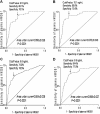Relationship between plasma high mobility group box-1 protein levels and clinical outcomes of aneurysmal subarachnoid hemorrhage
- PMID: 22883976
- PMCID: PMC3424135
- DOI: 10.1186/1742-2094-9-194
Relationship between plasma high mobility group box-1 protein levels and clinical outcomes of aneurysmal subarachnoid hemorrhage
Abstract
Background: High-mobility group box 1 (HMGB1), originally described as a nuclear protein that binds to and modifies DNA, is now regarded as a central mediator of inflammation by acting as a cytokine. However, the association of HMGB1 in the peripheral blood with disease outcome and cerebrovasospasm has not been examined in patients with aneurysmal subarachnoid hemorrhage.
Methods: In this study, 303 consecutive patients were included. Upon admission, plasma HMGB1 levels were measured by ELISA. The end points were mortality after 1 year, in-hospital mortality, cerebrovasospasm and poor functional outcome (Glasgow Outcome Scale score of 1 to 3) after 1 year.
Results: Upon admission, the plasma HMGB1 level in patients was statistically significantly higher than that in healthy controls. A multivariate analysis showed that the plasma HMGB1 level was an independent predictor of poor functional outcome and mortality after 1 year, in-hospital mortality and cerebrovasospasm. A receiver operating characteristic curve showed that plasma HMGB1 level on admission statistically significantly predicted poor functional outcome and mortality after 1 year, in-hospital mortality and cerebrovasospasm of patients. The area under the curve of the HMGB1 concentration was similar to those of World Federation of Neurological Surgeons (WFNS) score and modified Fisher score for the prediction of poor functional outcome and mortality after 1 year, and in-hospital mortality, but not for the prediction of cerebrovasospasm. In a combined logistic-regression model, HMGB1 improved the area under the curve of WFNS score and modified Fisher score for the prediction of poor functional outcome after 1 year, but not for the prediction of mortality after 1 year, in-hospital mortality, or cerebrovasospasm.
Conclusions: HMGB1 level is a useful, complementary tool to predict functional outcome and mortality after aneurysmal subarachnoid hemorrhage. However, HMGB1 determination does not add to the accuracy of prediction of the clinical outcomes.
Figures


References
-
- Drake C. Report of world federation of neurological surgeons committee on a universal subarachnoid hemorrhage grading scale. J Neurosurg. 1988;68:985–986. - PubMed
-
- Turck N, Vutskits L, Sanchez-Pena P, Robin X, Hainard A, Gex-Fabry M, Fouda C, Bassem H, Mueller M, Lisacek F, Puybasset L, Sanchez JC. A multiparameter panel method for outcome prediction following aneurysmal subarachnoid hemorrhage. Intensive Care Med. 2010;36:107–115. doi: 10.1007/s00134-009-1641-y. - DOI - PubMed
MeSH terms
Substances
LinkOut - more resources
Full Text Sources

